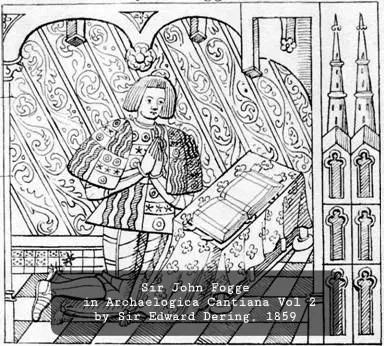
Thank you to author Amanda Harvey Purse for sharing this article with us today, an article which is based on research she did for her book on the Boleyns.
Over to Amanda..
On 9th October 2019, The Anne Boleyn Files kindly published my article of research on Sir John Fogge and his connection with the Boleyn family, research from my forthcoming book, The Boleyns: From the Tudors to the Windsors – see the article here. However, this was not the first time I had heard of the name Sir John Fogge. This shows that events within history, through connections, can work in circles, often bringing a researcher back to where they had originally started from. For this particular article, I would like to discuss the full circle I have been on with the family of Sir John Fogge and the many interesting twists and turns that can connect the Boleyn extended family to the story of King Richard III, and even the story of the ‘Princes in the Tower’.
It was in 1991 that I first came across the name Sir John Fogge. This was when a local writing competition was launched, asking for people to write a compelling story. Unbeknown to me, this would be my first chance to write as a researcher and, to some extent, a historian. I can safely state that I caught the writing bug at this moment thirty years ago.
I chose to write on the story of Richard Plantagenet, known to some as Richard of Eastwell. This was the story suggested to have been mainly brought about in Francis Peck’s Desiderata Curiosa, printed between 1732 and 1735. This book came in two volumes: the first was mainly a biography of Queen Elizabeth I’s Lord High Treasurer, Sir William Cecil, Lord Burghley, but the second, however, contained other interesting articles, and one was about Richard Plantagenet.
This is not the story of King Richard III, the last Plantagenet king, as you may expect from the naming of this person. I certainly was shocked to find that out at the time, but rather the story of his illegitimate son.
Richard Plantagenet of Eastwell
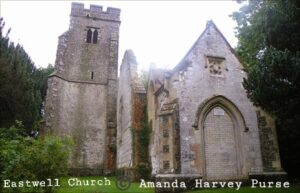
The story has its basis in a letter allegedly written by a clergyman from Wye, near Ashford, in 1733. In this story, Richard Plantagenet never knew his parents and was trained to be a bricklayer by a Kent family. In 1485, this boy was taken to the Battle of Bosworth, where he met King Richard III and was told that he was the king’s son. If King Richard won the battle, the boy would be classed his heir; however, if King Richard lost or died in battle, the son was to carry on the life he had started in Kent without uncovering his true identity. As we know, King Richard lost and died at the Battle of Bosworth and the ‘son’ is said to have travelled back to Ashford in Kent, where he later died, being buried in Eastwell Church.1
There is now, as was the case in 1991, no real evidence for this story. However, because of one single document, I was interested in finding out more at the time. This document was a church burial record for Monday 22nd December 1550. It stated that a man named ‘Rychard Plantagenet’ was buried at Eastwell Church.2 Visiting the ruins of Eastwell Church, I was also able to discover a stone tomb in its grounds. Overgrown with plant life, this tomb was not in great condition; weather and time were factors. However, there was a stone plaque placed at one end of this tomb – again not in the best condition (but has since been cleaned) – perhaps highlighting that it had been placed there a while ago, but the words could still be read. Those were: ‘Reputed to be the tomb of Richard Plantagenet, 22nd December 1550’
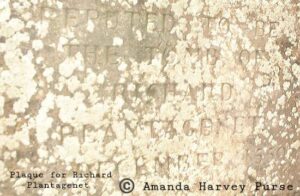
This could be seen as convincing proof that the story of King Richard III’s son was true. In fact, proof that this story was still believed became clear in 2013, when probably due to the popularity in the finding of King Richard’s body in a car park in Leicester through the use of DNA techniques, the BBC reported that Councillor Winston Michael, who, they stated represented Eastwell at the time, wanted the same DNA techniques used to identify King Richard to identify his purported son.3
When I looked into the history of this tomb, I found that the slab on top was once said to have depicted a husband and wife, with children, wearing clothes that were the fashion in the 1480s. However, the Richard of this story is not meant to have had a wife or children, and the clothing seemed to suggest that this tomb was for a family that had died before Richard’s death. This could also suggest that the plaque with Richard’s name on it was added much later and that Richard’s burial place has been lost.
What has this got to do with Sir John Fogge?
There is another theory about Richard Plantagenet. Could it possibly be that in 1483 when King Richard had left London for his Progress around the country, that an attempt was made to abduct King Edward IV’s sons, the later mentioned ‘Princes in the Tower’, during ‘Buckingham’s Rebellion’? What if this abduction was successful? Would this explain why, when King Richard was being accused of doing away with the boys, that he did not show the boys to the world to prove his innocence? Was it that he couldn’t show them because they had already been taken from his care, which wouldn’t have looked good for him?
It has been suggested that the older of the two boys, Edward, was a weak child. So, this brings a suggestion that Edward may have died, due to his ill health, while in the Tower of London, but what of the other boy, the other brother, named Richard? Did he escape, and, if so, where did he go?
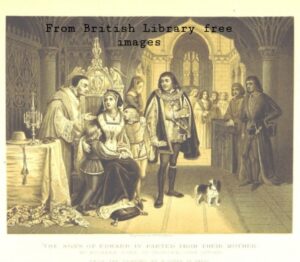
It is rather interesting, although it doesn’t prove anything, that when in King Henry VII’s reign there were pretenders to his throne, the ones suggesting they were Edward seem to have been dismissed rather quickly. Still, the one suggesting he was Richard seems to have been taken at the time with more interest.
This theory goes that Richard, Duke of Shrewsbury, the boy in the tower, was sent to live with one of his abductors to live out his life quietly and secretly. What if one of the abductors was Sir John Fogge?
He was a man known to have sided with the ‘Earl of Richmond’, the future King Henry VII, rather than King Richard. More importantly, he had been previously loyal to King Edward IV and had been given the role of Chamberlain to the Prince of Wales, Edward, the older boy in the tower. So, it is possible that he would have known King Edward IV’s boys very well indeed. Could this suggest a man willing to rescue King Edward IV’s boys while King Richard was away?
In ‘Buckingham’s Rebellion’, when the Duke of Buckingham had tried to gain support to overthrow King Richard, most of Buckingham’s supporters came from Kent. Sir John came from Ashford in Kent, and he owned many lands within that county.
We also know that Sir John had married for the second time to Alice Haute in 1458. This marriage is important for two reasons; firstly, the couple had three daughters, Anne, Elizabeth and Margaret Fogge. Margaret Fogge later married Sir Humphrey Stafford. They had met through her father, Sir John, as Humphrey Strafford was Sir John’s ward. Margaret and Sir Humphrey would have six children in total, three sons and three daughters. The second son of this couple was William Stafford. As the second son, William was not seen as a man of high status, so became a soldier for King Henry VIII and later became one of the king’s bodyguards.4
The Boleyn Connection
In 1532, William was one of the soldiers who travelled to France with the king. The reason for this event was for the king to show off his new wife-to-be, Anne Boleyn, and hopefully get the King of France’s support for King Henry’s annulment of his first marriage.
Anne’s sister, Mary Boleyn, was also on this trip. This could be the moment where William Stafford and Mary Boleyn met and fell in love. Being the daughter of Thomas Boleyn, the niece of Thomas Howard, two important men within the English Court and the sister to the next Queen of England, Mary must have seemed to have had excellent marriage prospects for William.
Although William had his own connections to the royal family – he was, after all, the second cousin of King Henry VIII’s grandmother – the connection wasn’t close, so William was considered a commoner, certainly in the eyes of the Boleyn family anyway.
The Woodville (or Wydeville) Connection
The second reason why the marriage between Sir John Fogge and Alice Haute could be deemed as important is that it gave Sir John family connections to the Woodville (also known as Wydeville) family too. Alice was the first cousin of Elizabeth Woodville, mother of the Princes in the Tower. Alice had also been in Elizabeth’s service during her time as King Edward IV’s queen, so there is a possibility that the boy Richard would have known Alice already. Could we suggest the boy was taken into the care of Sir John Fogge in Ashford so that the boy could live quietly and secretly with his mother’s side of the family?
Sir John Fogge was well-known in Ashford. He helped build Ashford College, a building that still stands today, but is now a part of Ashford’s museum. He is also remembered in our modern-day minds with the naming of a road, Sir John Fogge Avenue. Fogge also built St Mary’s Church, the main church in Ashford’s town centre today, and his resting place is found there. Would anyone question this man taking on a ward, paying for his education or even paying for a career in bricklaying, a job that may not be normally classed for a royal but a job that would have seen the boy financially settled?
With the burial record of a ‘Richard Plantagenet’ of Eastwell Church being known and with Eastwell not being that far away from Ashford in Kent, could we imagine a possibility that instead of the record suggesting King Richard III’s illegitimate son, it was a record of one of King Edward VI’s sons? One of the ‘Princes in the Tower’? Of course, being King Edward’s son, he too would be a Richard Plantagenet?
The thought that one of the ‘Princes in the Tower’ had survived is very tempting to believe. However, at the same time, it is still very debatable, with a DNA test on the bones that were found at the foot of the stairs of the White Tower in the Tower of London not being possible at the moment. Maybe one day we will know, and, in turn, know what, if any, involvement Sir John Fogge, Mary Boleyn’s future grandfather-in-law, had in the matter.
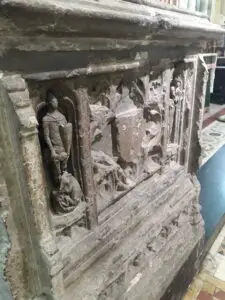
Sir John Fogge passed away on 9th November 1490, and because he had built the main church within Ashford town, St Mary’s, he was buried beneath a grand altar-tomb in that church. Sir John’s tomb was situated in what is now called St Nicholas’ Chapel, however, it was referred to as Repton Chapel in previous years, named after the place in which Sir John Fogge spent his final days: Repton Manor, on the outskirts of Ashford.
If you were to look closely in this church, you might just be able to see a jousting helmet on the wall near his tomb. The helmet once belonged to Sir John Fogge, and he is also celebrated in a memorial window. Sir John’s family still plays an important role within Ashford, as everyone who is baptised at the church uses the font that the Fogge family bought for St Mary’s Church.
This font is quite interesting to look at, now we know a little more about the background of Sir John Fogge. Built within the Tudor period, when codes and symbols meant everything, the font is decorated with the Fogge family’s coat of arms entwined with Tudor roses. This may give us a clue to the connection the Fogge family may have believed they had with the Tudor royal family. This maybe because of Sir John Fogge’s connection to the royals through King Henry VIII through his grandmother, as mentioned within this article, or it may be through another, more later, suggested connection…
The Parr Connection?
Although documents are limited, there is a suggestion that Sir John Fogge and Alice Haute gave birth to another little girl in Ashford in 1469. This would have been eleven years after their marriage and at a time when Sir John had been given the manors of Tonford in Thanington and Dane Court in Boughton under Blean, as well as being presented with a knighthood. Sir John was also given the office of Keeper of the Writs and was the Treasurer of the Household to King Edward IV.5 He, as mentioned before, was also given the role of Chamberlain to the young Prince of Wales Edward. It is possible that the family could indeed afford to give another child a good childhood and education. As the dates of birth for John and Alice’s other children, Anne, Elizabeth and Margaret Fogge differ in different sources, it is difficult to know if this particular baby girl was older or younger than them.
Nevertheless, it is suggested that this child was named Jane, and it is this Jane that married Thomas Greene in 1483 in Norton, Northamptonshire. The couple are said to have had ten children, six sons and four daughters. One of these daughters was Maud Green (or Greene) . This Maud Green is the Maud that was lady in waiting to Katherine of Aragon, King Henry VIII’s first wife, from 1509. It is said that these two ladies got on so well with each other that when Maud gave birth to a baby girl, she named her child Catherine after the queen and Queen Katherine was her godmother. This Catherine, grew up and married four times. One of her husbands was King Henry VIII . This Catherine was Catherine Parr.
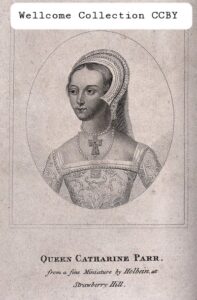
If it’s true that the Jane Fogge who married Thomas Greene in 1483 was a child of Sir John Fogge, then not only was his grandchild a lady in waiting to a Tudor queen consort, but his great-grandchild would become a Tudor queen consort herself. This is an interesting concept to think about when we think back to the font paid for by the Fogge family, that has their coat of arms entwined with Tudor roses.
Again, it is all very debatable, with documents being limited to us so far, but what is perhaps most interesting is that through one single marriage, that of Sir John Fogge and Alice Haute, we have family connections to the Woodville and Boleyn families, and, quite possibly, to Catherine Parr. All powerful families that have their own rooted connections that seem to knot themselves around the Tudor Rose of the Tudor dynasty.
About the author

Notes
- D. Baldwin, The Lost Prince – the survival of Richard of York. Stroud 2007.
- Ibid.
- https://www.bbc.co.uk/news/uk-england-kent-21366578
- The Mistresses of Henry VIII by Kelly Hart. The History Press 2009.
- Elizabeth, England’s Slandered Queen – Arelene Okerlund.
- Douglas Richardson. Magna Carta Ancestry: A Study of Colonial and Medieval Families. 2nd Edition 2011.